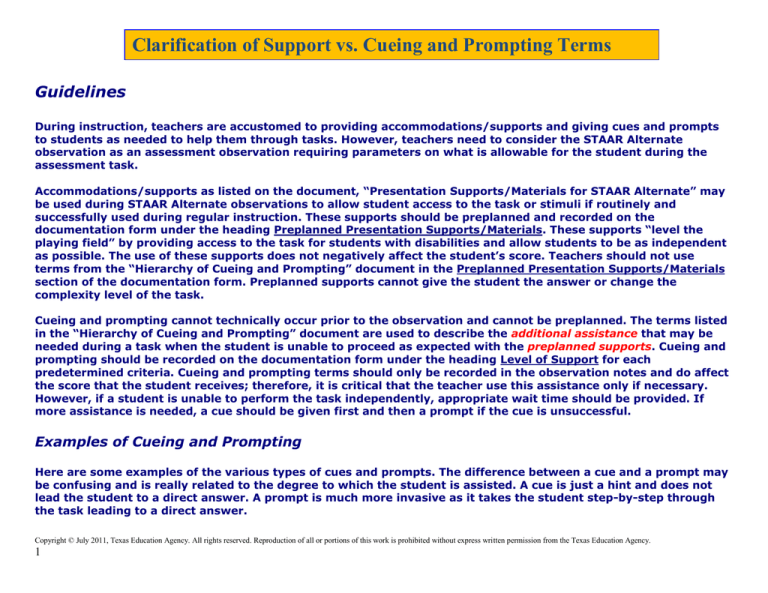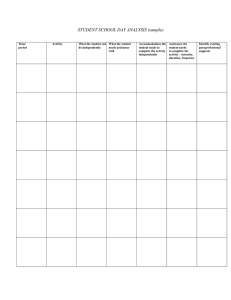
Clarification of Support vs. Cueing and Prompting Terms
Guidelines
During instruction, teachers are accustomed to providing accommodations/supports and giving cues and prompts
to students as needed to help them through tasks. However, teachers need to consider the STAAR Alternate
observation as an assessment observation requiring parameters on what is allowable for the student during the
assessment task.
Accommodations/supports as listed on the document, “Presentation Supports/Materials for STAAR Alternate” may
be used during STAAR Alternate observations to allow student access to the task or stimuli if routinely and
successfully used during regular instruction. These supports should be preplanned and recorded on the
documentation form under the heading Preplanned Presentation Supports/Materials. These supports “level the
playing field” by providing access to the task for students with disabilities and allow students to be as independent
as possible. The use of these supports does not negatively affect the student’s score. Teachers should not use
terms from the “Hierarchy of Cueing and Prompting” document in the Preplanned Presentation Supports/Materials
section of the documentation form. Preplanned supports cannot give the student the answer or change the
complexity level of the task.
Cueing and prompting cannot technically occur prior to the observation and cannot be preplanned. The terms listed
in the “Hierarchy of Cueing and Prompting” document are used to describe the additional assistance that may be
needed during a task when the student is unable to proceed as expected with the preplanned supports. Cueing and
prompting should be recorded on the documentation form under the heading Level of Support for each
predetermined criteria. Cueing and prompting terms should only be recorded in the observation notes and do affect
the score that the student receives; therefore, it is critical that the teacher use this assistance only if necessary.
However, if a student is unable to perform the task independently, appropriate wait time should be provided. If
more assistance is needed, a cue should be given first and then a prompt if the cue is unsuccessful.
Examples of Cueing and Prompting
Here are some examples of the various types of cues and prompts. The difference between a cue and a prompt may
be confusing and is really related to the degree to which the student is assisted. A cue is just a hint and does not
lead the student to a direct answer. A prompt is much more invasive as it takes the student step-by-step through
the task leading to a direct answer.
Copyright © July 2011, Texas Education Agency. All rights reserved. Reproduction of all or portions of this work is prohibited without express written permission from the Texas Education Agency.
1
Visual Cues and Prompts
Visual representations are often important to students with significant cognitive disabilities. The difference between the use of a visual cue
(cueing) and a visual graphic (prompting) may be especially confusing to teachers. A visual cue is just one visual that alerts the student on
where to focus or where to respond. The visual graphic is a series of visual directions that pull the student through the task to completion and
provides the answer.
Remember that visual cues and prompts occur after the observation begins and cannot be part of the original materials the teacher has provided for a
specific task. A visual graphic can never be used as a support, since it is the source of direct answers.
Copyright © July 2011, Texas Education Agency. All rights reserved. Reproduction of all or portions of this work is prohibited without express written permission from the Texas Education Agency.
2
Verbal Cues and Prompts
The difference between the verbal cueing and prompting terms is determined by the amount of verbal information given and the specificity of
the oral information. Task directions that the teacher provides at the beginning of the task to tell the student what is expected are part of the
presentation and are not counted as cues or prompts. If repeated more than once, the teacher will need to specify the number of additional
repetitions and list them as a support. Repetitions over the specified amount must be counted as cues.
Remember that verbal cues and prompts occur after the observation has begun and are not part of the oral directions the teacher has planned to provide
during the specific task. Verbal direction can never be used as a support, since it is the source of a direct answer.
Copyright © July 2011, Texas Education Agency. All rights reserved. Reproduction of all or portions of this work is prohibited without express written permission from the Texas Education Agency.
3
Physical Cues and Prompts
The difference between physical cues and prompts is a matter of degree as evidenced in the following examples.
Remember that due to limitations in mobility, some students may need assistance with physical access to a task as part of the supports. In these instances
the physical assistance can only help the student access the stimuli. The assistance cannot result in the teacher performing the verb in the predetermined
criteria for the student. Gesture and physical assists can never be used as supports since they are the source of direct answers and must always be counted
as a prompt.
If a student begins to struggle, sufficient wait time should be provided. If the student still cannot demonstrate the skill, a cue should be given. If cues
prove ineffective, a prompt will need to be given. Withholding cues and prompts will result in an unfair observation since the student was not given every
opportunity to perform the skill.
Copyright © July 2011, Texas Education Agency. All rights reserved. Reproduction of all or portions of this work is prohibited without express written permission from the Texas Education Agency.
4

